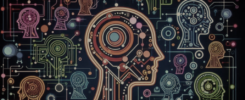Nick Baker, Director of the Office of Open Learning
With so many potential uses for generative AI emerging, especially since the release of OpenAI’s GPTs and Poe.com’s Build a Bot, the barrier to experimenting with these tools for almost any imaginable purpose has been lowered significantly. Educators have started building generative AI-based bots that can do everything from acting as a personal tutor within a specific course, to finding resources, generating ALT text for images to improve accessibility. These same tools may lower the barrier to creating, adapting, translating, and updating Open Educational Resources (OERs) such as open textbooks, improving the feasibility and sustainability of adopting an open approach.
While the academic world is still trying to wrap its head around the impact of generative AI on their disciplines, there are at least two emerging areas where AI and Open Educational Practices (OEP) are intersecting that are worth exploring. The first, as suggested above, is the potential these tools have in supporting the development and modification of OERs. There are hundreds of tools now available to help generate or edit content, from text, to images, slides, code, music, and videos. Tools like Nolej are able to generate interactive learning content, while others like Slidespilot or Gamma can generate draft PowerPoint slides, and still others such as HeyGen or Synthesia are able to create videos from text prompts and even translate them to other languages. They are also good at generating content like practice questions, rubrics, and feedback for learners (Bozkurt, 2023). All of these tools come at a cost however, so there should be careful consideration of how much value you can get out of the efficiencies they may create, along with who is able to afford access and which countries have access to the latest and best models (many are not available in Canada for example).
The second intersection is crowdsourcing and sharing openly about experimentation with generative AI in teaching and learning. For example, Chrissi Nerantzi from Leeds University crowdsourced and edited a collection of pedagogical ideas for using generative AI, 101 Creative ideas to use AI in education (Nerantzi et al., 2023). Similarly, Anna Mills (Canada College) crowdsourced a collection of ideas on AI Text Generators: Sources to Stimulate Discussion Among Teachers and shared it openly as part of a larger project. Lance Eaton (College Unbound) collected hundreds of example syllabus policies to help fellow educators decide (and describe) how they might consider the use of generative AI in their courses. This kind of open sharing of practice and work in progress is critical with a technology set that is changing so rapidly that it is almost impossible to keep up with the daily developments. It may also encourage educators to consider co-creation of learning resources with students and AI, both as a means of generating OER content, and to help students learn how to use them responsibly and safely.
While there remain many unknowns, potential risks, and challenges with the use of generative AI, the use of open educational practices may help to buffer higher education against the worst of these if educators actively engage with the tools and each other, and work towards the common good (Mills, Bali & Eaton, 2023). It is now possible to imagine a time in the near future where generative AI tools will be able to dynamically create or adapt course materials to meet the needs of individual learners (for example, adapting to disability needs, translating a set of key terms, or interacting directly with students as a tutor), draw directly from open data sources, analyse those data and insert summaries into learning materials, or create localised versions of content for review by instructors. Being open and transparent about our use and experiences helps us to identify safe, equitable, and ethical practices for AI and Openness.
References
Bozkurt, A. (2023). Generative AI, Synthetic Contents, Open Educational Resources (OER), and Open Educational Practices (OEP): A New Front in the Openness Landscape. Open Praxis, 15(3), pp. 178–184. DOI: https://doi.org/10.55982/openpraxis.15.3.579
Mills, A. (2023). AI Text Generators: Sources to Stimulate Discussion Among Teachers. Online: https://bit.ly/AITextEdu
Mills, A., Bali, M. and Eaton, L. (2023). How do we respond to generative AI in education? Open educational practices give us a framework for an ongoing process. Journal of Applied Learning and Teaching 6(1).
Nerantzi, C., Abegglen, S., Karatsiori, M. and Martinez-Arboleda, A. (Eds.) (2023). 101 Creative ideas to use AI in education. A collection curated by #creativeHE. Graphic Design by Bushra Hashim. CC-BY-NC-SA 4.0. Online: https://zenodo.org/records/8072950
